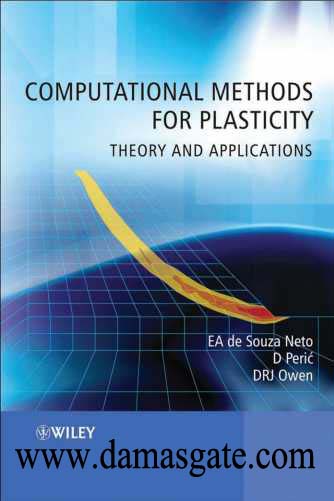Computational Methods for Plasticity - Theory and Applications

COMPUTATIONAL
METHODS FOR
PLASTICITY
THEORY AND APPLICATIONS
EA de Souza Neto
D Peri'c
DRJ Owen
Civil and Computational Engineering Centre, Swansea University
PREFACE
HE purpose of this text is to describe in detail numerical techniques used in small and
large strain finite element analysis of elastic and inelastic solids. Attention is focused
on the derivation and description of various constitutive models – based on phenomenological
hyperelasticity, elastoplasticity and elasto-viscoplasticity – together with the relevant
numerical procedures and the practical issues arising in their computer implementation
within a quasi-static finite element scheme. Many of the techniques discussed in the text are
incorporated in the FORTRAN program, named HYPLAS, which accompanies this book and
can be found at . This computer program has been specially
written to illustrate the practical implementation of such techniques. We make no pretence
that the text provides a complete account of the topics considered but rather, we see it as an
attempt to present a reasonable balance of theory and numerical procedures used in the finite
element simulation of the nonlinear mechanical behaviour of solids.
When we embarked on the project of writing this text, our initial idea was to produce
a rather concise book – based primarily on our own research experience – whose bulk
would consist of the description of numerical algorithms required for the finite element
implementation of small and large strain plasticity models. As the manuscript began to take
shape, it soon became clear that a book designed as such would be most appropriate to those
already involved in research on computational plasticity or closely related areas, being of
little use to those willing to learn computational methods in plasticity from a fundamental
level. A substantial amount of background reading from other sources would be required for
readers unfamiliar with topics such as basic elastoplasticity theory, tensor analysis, nonlinear
continuum mechanics – particularly nonlinear kinematics – finite hyperelasticity and general
dissipative constitutive theory of solids. Our initial plan was then gradually abandoned as
we chose to make the text more self-contained by incorporating a considerable amount of
basic theory. Also, while writing the manuscript, we decided to add more advanced (and very
exciting) topics such as damage mechanics, anisotropic plasticity and the treatment of finite
strain single crystal plasticity. Following this route, our task took at least three times as long
to complete and the book grew to about twice the size as originally planned. There remains
plenty of interesting material we would like to have included but cannot due to constraints
of time and space. We are certainly far more satisfied with the text now than with its early
versions, but we do not believe our final product to be optimal in any sense. We merely offer
it to fill a gap in the existing literature, hoping that the reader will benefit from it in some way.
The text is arranged in three main parts. Part One presents some basic material of relevance
to the subject matter of the book. It includes an overview of elementary tensor analysis,
continuum mechanics and thermodynamics, the finite element method in quasi-static nonlinear
solid mechanics and a brief description of the computer program HYPLAS.PartTwo
deals with small strain problems. It introduces the mathematical theory of infinitesimal
plasticity as well as the relevant numerical procedures for the implementation of plasticity
models within a finite element environment. Both rate-independent (elastoplastic) and ratedependent
(elasto-viscoplastic) theories are addressed and some advanced models, including
anisotropic plasticity and ductile damage are also covered. Finally, in Part Three we focus
on large strain problems. The theory of finite hyperelasticity is reviewed first together with
details of its finite element implementation. This is followed by an introduction to large strain
plasticity. Hyperelastic-based theories with multiplicative elastoplastic kinematics as well as
hypoelastic-based models are discussed, together with relevant numerical procedures for their
treatment. The discussion on finite plasticity and its finite element implementation culminates
with a description of techniques for single crystal plasticity. Finite element techniques for
large-strain near-incompressibility are also addressed.
Download
*